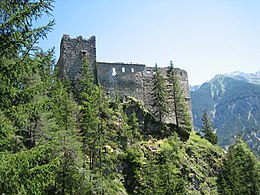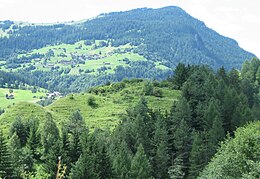Barons of Vaz

The barons of Vaz or Vatz were one of the most powerful noble families in the Alpine region in the High Middle Ages . They are documented from around 1135 to 1338. Today's Vaz / Obervaz community is part of their estate. The headquarters of the von Vaz family was Nivagl Castle south of Zorten , and later Belfort Castle . Nivagl dates from the 10th or early 11th century and is therefore one of the oldest castles in Upper Council .
family
The ruling core of those of Vaz is already recorded in the Churrätisches Reichsguturbar . In the course of time, the Nivagl family spread to large parts of Upper Council and developed into the most important political power there alongside the diocese of Chur . Until 1299 the barons of Vaz were pledges of the imperial bailiwick of the Chur monastery, later of the so-called Grafschaft Laax , a fief of the empire to Austria. The majority of their rights to extensive land in Linzgau north of Lake Constance were based on property rights to the Seefelden parish church and were sold in the 13th century.
The barons of Vaz owned rights to over 25 castles in Graubünden; from Neu-Aspermont in the Bündner Herrschaft to Jörgenberg in the Surselva , from Ortenstein in the south of the Domleschg to Splügen in the Rheinwald .
The burial place of the Vazer was the Premonstratensian Monastery of Churwalden , whose founder could have been a Vazer. Walter, recorded in 1135 as the debtor of the community of Plurs in Valtellina , was in 1158 as Walter de Sevelt Vogt of the Seefelden Church. His sons were Walter and Rudolf, who was married to Willibirg, daughter of Count Manegold II of Veringen , and in 1192 at the court of King Heinrich VI. is proven in Hagenau in Alsace.

Main representatives
- Walter I. von Vaz , mentioned in a document from 1135 to 1160; † before March 10, 1169
- Walter II , son of Walter I, mentioned in 1160
- Rudolf l. von Vaz , son of Walter I., Vogt of the Seefelden Church † before 1200, married to Countess Willibirg von Veringen
- Walther von Vatz († January 18, 1213) was Bishop of Gurk .
- Rudolf II. Son of Walter I, † before 1227
- Walter III. von Vaz , † November 26, 1254; Son of Walter I, married to Adelheid von Rapperswil
- Rudolf III. , Son of Walter III, † July 27, 1262 as Rudolf IV of Rapperswil, Count of Rapperswil
- Walter IV. von Vaz , son of Walter III. married to Adelheid von Montfort ; † before April 25, 1255
- Walter V. , son of Walter IV., † November 4, 1284, married to Liukarda von Kirchberg, † May 24, 1326
- Donat , son of Walter V., † April 23, 1337/38 in Churwalden, married to Guota von Ochsenstein
- Margarethe , daughter of Walter V., married 1st to Ulrich II. Von Matsch , † 1309, 2nd to Ulrich von Aspermont , † 1333
- N , daughter of Walter V., married to Walter IV. Von Eschenbach
- Kunigunde , daughter of Donat, † 5./6. February 1364, married to Friedrich V of Toggenburg
- Ursula , daughter of Donat, † April 4, 1367, married to Rudolf IV., Count von Werdenberg-Sargans , † December 27, 1361; murdered near Chiavenna
More information
On March 4, 1213, it is documented that Adelheid von Montfort transferred the part of her goods in Seefelden, Maurach and Tüfingen received as a morning gift from his husband Walter von Vaz to the Salem monastery and that a good in Obervaz and taxes from Alp Sanapans ( Lenzerheide ) and received from Davos .
In 1275 Walter IV. Received from the Bishop of Chur some possessions in Domleschg as hereditary fiefs, including Tomils with the Ortenstein Castle . Since they already owned the Neu-Süns and Alt-Süns castles near Paspels and Heinzenberg Castle , the Vazers in Domleschg were given a prominent position.
Donat von Vaz was considered a liberator and popular hero of Graubünden. He was a law student at the University of Bologna from 1295 to 1298 and then became canon in Chur. In 1300, after the death of his brother Johannes, he took over the rule of Vaz. Politically, he leaned against Austria and cultivated relations with Zurich. For wall paintings in churches, he gave orders to the Waltensburg master . He was often involved in violent battles against the Bishop of Chur and was therefore celebrated as a democrat and liberator of Graubünden in the liberal historiography of the 19th and 20th centuries as well as in stories and popular dramas. Donat's inheritance passed to the daughters Kunigunde and Ursula, the countesses of Toggenburg and Werdenberg-Sargans. The Belfort Castle of Lenzerheide was inherited by sister Cunegonde and took it into the possession of the Counts of Toggenburg over.
In 1456, the bishop of Chur, the Schams and Obervaz bought Ursula's inheritance from the impoverished Count of Werdenberg-Sargans for 3,600 guilders. Obervaz paid 600 guilders, about 11,000 francs, for his area. In the same year Vaz / Obervaz was able to buy out and became an independent municipality.
literature
- Otto P. Clavedetscher, Werner Meyer : The castle book of Graubünden . Zurich / Schwäbisch Hall, 1984
- Annual Report of the Archaeological Service Graubünden 2007 ; P. 75ff
- Florian Hitz: Dynasty politics and castle building - The barons of Vaz in their network of relationships , in: Bündner Monatsblatt 2/2009, p. 117ff
Web links
- Jürg Leonhard Muraro: Vaz, from. In: Historical Lexicon of Switzerland .
